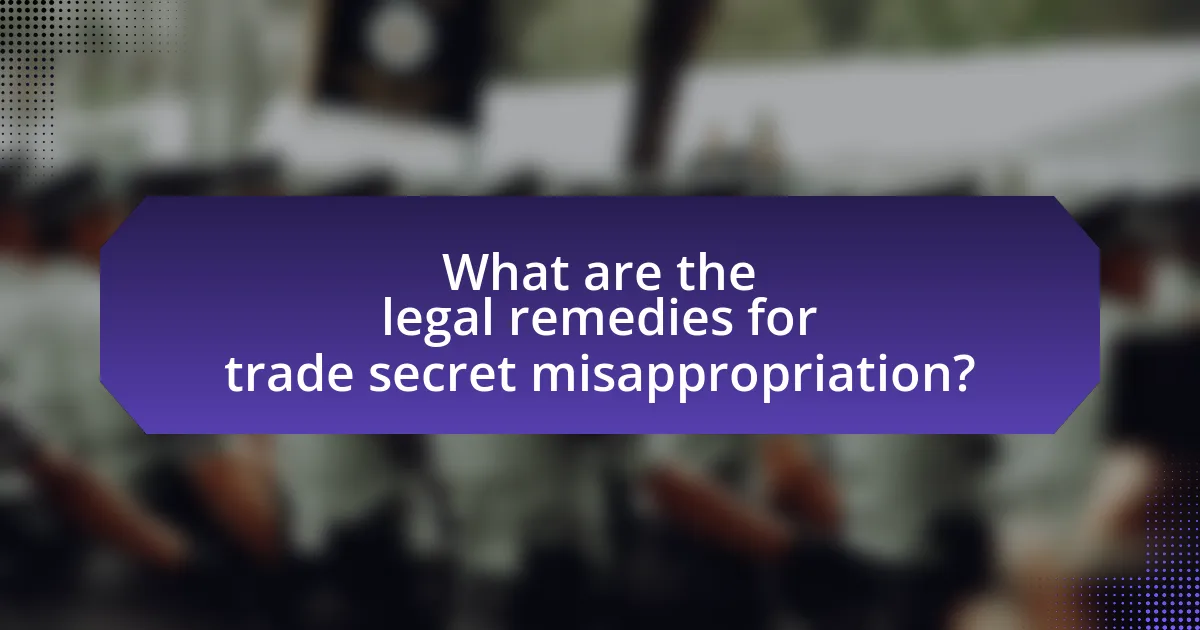The legal framework surrounding trade secrets in the U.S. is primarily defined by the Uniform Trade Secrets Act (UTSA) and the Defend Trade Secrets Act (DTSA) of 2016. These laws establish criteria for what constitutes a trade secret, emphasizing the need for information to be secret, economically valuable, and subject to reasonable efforts for maintaining its confidentiality. The article explores the definitions, criteria, and legal protections offered by both state and federal laws, as well as the importance of trade secrets in business competitiveness and innovation. Additionally, it discusses the legal remedies available for misappropriation, the role of non-disclosure agreements, and best practices for businesses to safeguard their trade secrets effectively.

What is the Legal Framework Surrounding Trade Secrets in the U.S.?
The legal framework surrounding trade secrets in the U.S. is primarily governed by the Uniform Trade Secrets Act (UTSA) and the Defend Trade Secrets Act (DTSA) of 2016. The UTSA, adopted by most states, defines trade secrets as information that derives independent economic value from not being generally known and is subject to reasonable efforts to maintain its secrecy. The DTSA provides federal protection for trade secrets, allowing trade secret owners to file civil lawsuits in federal court for misappropriation. Both laws emphasize the importance of maintaining confidentiality and outline remedies for misappropriation, including injunctions and damages. The combination of state and federal laws creates a comprehensive legal framework that protects trade secrets across the United States.
How are trade secrets defined under U.S. law?
Trade secrets under U.S. law are defined as information that is not generally known or readily accessible, derives economic value from its secrecy, and is subject to reasonable efforts to maintain its confidentiality. The Uniform Trade Secrets Act (UTSA) and the Defend Trade Secrets Act (DTSA) provide the legal framework for this definition, emphasizing that trade secrets can include formulas, practices, processes, designs, instruments, or patterns. The legal protection of trade secrets is contingent upon the owner taking reasonable measures to keep the information secret, which can include non-disclosure agreements and security protocols.
What criteria must information meet to qualify as a trade secret?
Information must meet three criteria to qualify as a trade secret: it must be secret, have economic value, and be subject to reasonable efforts to maintain its secrecy. The information is considered secret if it is not generally known or readily accessible to others who could obtain economic value from its disclosure or use. Economic value arises when the information provides a competitive advantage over those who do not know or use it. Reasonable efforts to maintain secrecy include measures such as non-disclosure agreements, restricted access, and other protective actions. These criteria are established under the Uniform Trade Secrets Act and the Defend Trade Secrets Act, which provide a legal framework for the protection of trade secrets in the U.S.
How do state and federal laws differ in defining trade secrets?
State and federal laws differ in defining trade secrets primarily in their scope and application. The Uniform Trade Secrets Act (UTSA), adopted by many states, defines trade secrets as information that derives independent economic value from not being generally known and is subject to reasonable efforts to maintain its secrecy. In contrast, the federal Defend Trade Secrets Act (DTSA) provides a broader definition that includes any information that is secret and has economic value, regardless of whether it is subject to reasonable efforts to maintain its secrecy. This distinction highlights that while state laws often emphasize the necessity of maintaining secrecy, federal law focuses more on the economic value of the information itself.
Why is the protection of trade secrets important?
The protection of trade secrets is important because it safeguards a company’s competitive advantage and proprietary information. By maintaining confidentiality around critical business processes, formulas, or customer lists, organizations can prevent competitors from gaining access to valuable insights that could undermine their market position. According to the Uniform Trade Secrets Act, which has been adopted by most U.S. states, trade secrets are defined as information that derives independent economic value from not being generally known and is subject to reasonable efforts to maintain its secrecy. This legal framework underscores the significance of protecting trade secrets, as it allows businesses to innovate and invest in research and development without the fear of losing their unique advantages to competitors.
What role do trade secrets play in business competitiveness?
Trade secrets are crucial for business competitiveness as they provide companies with a strategic advantage by safeguarding proprietary information that can enhance product quality, reduce costs, and improve operational efficiency. For instance, the Coca-Cola formula, a well-known trade secret, has allowed the company to maintain a unique market position and brand identity, contributing significantly to its competitive edge. According to the Economic Espionage Act of 1996, trade secrets are legally protected, which incentivizes innovation and investment in research and development, further solidifying their role in maintaining a competitive landscape.
How do trade secrets contribute to innovation and economic growth?
Trade secrets significantly contribute to innovation and economic growth by providing businesses with a competitive advantage that encourages investment in research and development. When companies protect their proprietary information, such as formulas, processes, or customer lists, they can innovate without the fear of competitors easily replicating their ideas. This protection fosters an environment where businesses are more likely to invest in new technologies and products, leading to advancements that drive economic growth. For instance, the U.S. economy benefits from trade secrets as they account for a substantial portion of the value of many industries, with estimates suggesting that trade secrets contribute over $5 trillion to the U.S. economy annually. This economic impact underscores the importance of trade secrets in promoting sustained innovation and enhancing overall economic performance.
What are the key laws governing trade secrets in the U.S.?
The key laws governing trade secrets in the U.S. are primarily the Uniform Trade Secrets Act (UTSA) and the Defend Trade Secrets Act (DTSA). The UTSA, adopted by most states, provides a legal framework for the protection of trade secrets, defining what constitutes a trade secret and outlining the remedies available for misappropriation. The DTSA, enacted in 2016, allows trade secret owners to bring a federal civil lawsuit for misappropriation and provides for ex parte seizure of property to prevent further dissemination of the trade secret. These laws collectively establish the legal standards and protections for trade secrets, ensuring that businesses can safeguard their confidential information from unauthorized use or disclosure.
What is the Uniform Trade Secrets Act (UTSA)?
The Uniform Trade Secrets Act (UTSA) is a model law that provides a legal framework for the protection of trade secrets in the United States. Enacted to create consistency across state laws, the UTSA defines trade secrets and outlines the legal remedies available for misappropriation. The act specifies that a trade secret is information that derives independent economic value from not being generally known and is subject to reasonable efforts to maintain its secrecy. As of 2023, 48 states have adopted the UTSA or similar legislation, reinforcing its significance in safeguarding proprietary business information.
How does the Defend Trade Secrets Act (DTSA) enhance trade secret protection?
The Defend Trade Secrets Act (DTSA) enhances trade secret protection by providing a federal cause of action for trade secret misappropriation. This federal framework allows trade secret owners to pursue legal remedies in federal court, which can lead to more uniformity in the application of trade secret laws across states. Additionally, the DTSA enables the possibility of obtaining ex parte seizure orders to prevent the dissemination of trade secrets, thereby offering immediate protection against misappropriation. The act also includes provisions for the recovery of damages, including punitive damages and attorney’s fees in cases of willful and malicious misappropriation, which serves as a stronger deterrent against violations.

What are the legal remedies for trade secret misappropriation?
The legal remedies for trade secret misappropriation include injunctive relief, monetary damages, and attorney’s fees. Injunctive relief allows a court to prohibit the misappropriator from using or disclosing the trade secret, thereby preventing further harm. Monetary damages can be awarded to compensate the trade secret owner for losses incurred due to the misappropriation, which may include lost profits or unjust enrichment of the misappropriator. Additionally, under the Defend Trade Secrets Act, a court may award attorney’s fees if the misappropriation was willful and malicious. These remedies are designed to protect the interests of trade secret owners and deter future violations.
What types of damages can be claimed in trade secret cases?
In trade secret cases, the types of damages that can be claimed include actual damages, unjust enrichment, and punitive damages. Actual damages refer to the economic harm suffered by the trade secret owner due to the misappropriation, which can be quantified based on lost profits or the value of the trade secret. Unjust enrichment damages are awarded to prevent the wrongdoer from benefiting from the trade secret at the expense of the owner, typically calculated based on the profits gained by the infringer. Punitive damages may also be awarded in cases of willful and malicious misappropriation to deter future violations. These damage types are supported by the Uniform Trade Secrets Act, which provides a legal framework for the protection and enforcement of trade secrets in the U.S.
How are actual damages calculated in trade secret litigation?
Actual damages in trade secret litigation are calculated based on the economic harm suffered by the trade secret owner due to the misappropriation of their trade secrets. This calculation typically involves assessing lost profits that the owner would have earned had the misappropriation not occurred, as well as any unjust enrichment gained by the party that misappropriated the trade secrets. Courts may consider factors such as the value of the trade secret, the duration of the misappropriation, and the market conditions affecting the trade secret’s value. For instance, in the case of E.I. du Pont de Nemours & Co. v. Christopher, the court emphasized the importance of demonstrating a clear link between the misappropriation and the actual damages incurred, reinforcing that actual damages must be substantiated with credible evidence.
What is the significance of punitive damages in trade secret cases?
Punitive damages in trade secret cases serve as a deterrent against willful and malicious infringement of trade secrets. These damages are significant because they not only compensate the injured party but also aim to punish the wrongdoer, thereby discouraging similar misconduct in the future. For instance, under the Uniform Trade Secrets Act, courts can award punitive damages when the misappropriation is found to be willful and malicious, reinforcing the importance of protecting confidential business information. This legal framework emphasizes the need for businesses to uphold ethical standards and respect proprietary information, ultimately fostering a fair competitive environment.
What legal actions can be taken against trade secret theft?
Legal actions against trade secret theft include civil lawsuits for misappropriation, which can result in injunctions to prevent further use or disclosure, monetary damages for losses incurred, and in some cases, punitive damages. The Defend Trade Secrets Act of 2016 allows for federal claims, enabling trade secret owners to seek remedies in federal court, while state laws, such as the Uniform Trade Secrets Act, provide similar protections at the state level. These legal frameworks establish the basis for enforcing rights against individuals or entities that unlawfully acquire or disclose trade secrets, ensuring that businesses can protect their confidential information from unauthorized use.
What is the process for filing a trade secret misappropriation lawsuit?
The process for filing a trade secret misappropriation lawsuit involves several key steps. First, the plaintiff must identify and define the trade secret that has been misappropriated, ensuring it meets the legal criteria of being secret, valuable, and subject to reasonable efforts to maintain its secrecy. Next, the plaintiff must gather evidence of misappropriation, which may include demonstrating how the defendant acquired the trade secret through improper means, such as theft or breach of confidentiality.
Following this, the plaintiff files a complaint in the appropriate court, detailing the facts of the case, the legal basis for the claim, and the relief sought. The defendant is then served with the complaint and given an opportunity to respond. Discovery follows, where both parties exchange relevant information and evidence. If the case does not settle, it proceeds to trial, where the plaintiff must prove misappropriation by a preponderance of the evidence.
This process is supported by the Uniform Trade Secrets Act, which provides a legal framework for trade secret protection and misappropriation claims across many states in the U.S.
How can injunctions be used to protect trade secrets?
Injunctions can be used to protect trade secrets by legally prohibiting individuals or entities from disclosing or using confidential information. When a trade secret is at risk of being misappropriated, a court can issue a temporary or permanent injunction to prevent further dissemination or exploitation of that information. This legal remedy is grounded in the Uniform Trade Secrets Act, which allows for injunctive relief to safeguard the economic interests of businesses by ensuring that proprietary information remains confidential. Courts have consistently upheld injunctions in cases where the disclosure of trade secrets could cause irreparable harm to the owner, thereby reinforcing the importance of protecting sensitive business information.

How can businesses effectively protect their trade secrets?
Businesses can effectively protect their trade secrets by implementing robust confidentiality agreements, conducting regular employee training, and establishing strict access controls. Confidentiality agreements legally bind employees and partners to maintain secrecy, thereby reducing the risk of unauthorized disclosure. Regular training ensures that employees understand the importance of trade secrets and the protocols for safeguarding them. Access controls limit information exposure to only those who need it for their work, minimizing the chances of leaks. According to the Uniform Trade Secrets Act, which has been adopted by most states, these measures are essential for maintaining the legal protection of trade secrets.
What best practices should companies implement to safeguard trade secrets?
Companies should implement a combination of confidentiality agreements, employee training, and robust security measures to safeguard trade secrets. Confidentiality agreements, such as non-disclosure agreements (NDAs), legally bind employees and partners to protect sensitive information, reducing the risk of unauthorized disclosure. Employee training programs educate staff on the importance of trade secrets and the specific practices to maintain confidentiality, fostering a culture of security within the organization. Additionally, companies should employ physical and digital security measures, including access controls, encryption, and secure storage solutions, to protect sensitive data from unauthorized access or theft. According to the Economic Espionage Act of 1996, the legal framework emphasizes the importance of protecting trade secrets, highlighting the need for proactive measures to prevent misappropriation.
How can employee training contribute to trade secret protection?
Employee training can significantly contribute to trade secret protection by educating employees on the importance of confidentiality and the legal implications of disclosing sensitive information. Training programs that emphasize the value of trade secrets and the potential risks associated with unauthorized sharing help create a culture of awareness and responsibility among staff. For instance, a study by the U.S. Department of Justice indicated that companies with robust employee training programs experience fewer incidents of trade secret theft. This highlights that informed employees are less likely to inadvertently compromise sensitive information, thereby enhancing the overall security of trade secrets within an organization.
What role do non-disclosure agreements (NDAs) play in protecting trade secrets?
Non-disclosure agreements (NDAs) serve a critical role in protecting trade secrets by legally binding parties to confidentiality regarding sensitive information. NDAs create a formal obligation for individuals or entities to refrain from disclosing proprietary information, thereby safeguarding the competitive advantage that trade secrets provide. According to the Uniform Trade Secrets Act, which has been adopted by many states, the existence of an NDA can strengthen a trade secret claim by demonstrating that reasonable efforts were made to maintain its secrecy. This legal framework underscores the importance of NDAs in ensuring that confidential business information remains protected from unauthorized access and disclosure.
What challenges do businesses face in protecting trade secrets?
Businesses face significant challenges in protecting trade secrets, primarily due to the difficulty in maintaining confidentiality and the risk of employee turnover. The legal framework surrounding trade secrets in the U.S. relies on the Uniform Trade Secrets Act and the Defend Trade Secrets Act, which provide some protection but require businesses to demonstrate reasonable efforts to maintain secrecy. For instance, a study by the Economic Espionage Act indicated that 80% of companies reported experiencing trade secret theft, highlighting the prevalence of this issue. Additionally, the rise of remote work has increased the risk of unintentional disclosures, making it harder for businesses to safeguard sensitive information.
How can digital transformation impact trade secret security?
Digital transformation can significantly impact trade secret security by increasing the risk of unauthorized access and data breaches. As organizations adopt digital technologies, they often store sensitive information, including trade secrets, in cloud environments and interconnected systems, which can be more vulnerable to cyberattacks. For instance, a report by IBM found that the average cost of a data breach in 2021 was $4.24 million, highlighting the financial implications of compromised trade secrets. Additionally, the shift to remote work during the COVID-19 pandemic has further exposed trade secrets to potential theft, as employees access sensitive information from less secure home networks. Therefore, while digital transformation offers operational efficiencies, it necessitates enhanced security measures to protect trade secrets effectively.
What are the risks associated with employee turnover regarding trade secrets?
Employee turnover poses significant risks to trade secrets, primarily through the potential for unauthorized disclosure of sensitive information. When employees leave, they may take proprietary knowledge, client lists, or operational processes with them, intentionally or unintentionally sharing this information with competitors. According to a study by the Ponemon Institute, 59% of employees believe that their former colleagues would share sensitive information with competitors, highlighting the vulnerability of trade secrets during transitions. Additionally, the Uniform Trade Secrets Act provides legal recourse for companies, but enforcing these protections can be challenging, especially if the departing employee has not signed a non-disclosure agreement. Thus, the risks associated with employee turnover regarding trade secrets include loss of competitive advantage, legal challenges, and the difficulty of safeguarding proprietary information.
What are the common pitfalls in trade secret management?
Common pitfalls in trade secret management include inadequate protection measures, failure to identify and document trade secrets, and insufficient employee training on confidentiality. Inadequate protection measures, such as not implementing non-disclosure agreements or security protocols, can lead to unauthorized access and disclosure. Failure to identify and document trade secrets results in a lack of clarity on what needs protection, making enforcement difficult. Insufficient employee training can lead to unintentional breaches, as employees may not fully understand their obligations regarding sensitive information. These pitfalls can significantly undermine the effectiveness of trade secret management and expose businesses to risks of misappropriation.
How can inadequate documentation lead to trade secret vulnerabilities?
Inadequate documentation can lead to trade secret vulnerabilities by failing to establish clear ownership and protection protocols for sensitive information. When companies do not maintain comprehensive records of their trade secrets, including how they are developed, used, and shared, they risk losing legal protection under the Uniform Trade Secrets Act (UTSA) and the Defend Trade Secrets Act (DTSA). These laws require that trade secrets be subject to reasonable efforts to maintain their secrecy; without proper documentation, it becomes challenging to prove that such efforts were made. For instance, a lack of documented policies or employee training on handling confidential information can result in unintentional disclosures, making it easier for competitors to access and exploit these trade secrets.
What mistakes should businesses avoid when enforcing trade secret rights?
Businesses should avoid several key mistakes when enforcing trade secret rights. First, failing to implement adequate protective measures can lead to the loss of trade secret status; for instance, not using non-disclosure agreements or not restricting access to sensitive information undermines legal claims. Second, neglecting to document the trade secret’s development and the steps taken to maintain its secrecy can weaken enforcement efforts, as courts require evidence of reasonable efforts to protect the information. Third, pursuing litigation without a clear strategy or understanding of the legal landscape can result in costly and ineffective outcomes, as seen in cases where businesses misjudge the strength of their claims. Lastly, overlooking the importance of employee training on trade secret policies can lead to inadvertent disclosures, as employees may not fully understand their obligations. These mistakes can significantly hinder a business’s ability to protect its trade secrets effectively.



